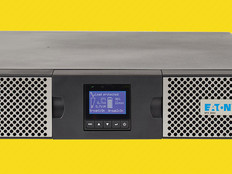New Technology Demands New Classroom Setup
Related Articles
Power, power, power! It’s not a monster-truck rally coming to your area; instead it’s the top necessity once you’ve decided to start a one-to-one program at your school. You’ve made a strong case for your program, trained your teachers, communicated with your parents, identified what technology to buy, installed your wireless network, but have you considered how to set up your classrooms?
Notebook PC programs can lead to a more student- centered approach to learning, where the teacher becomes a facilitator rather than a deliverer of knowledge. Students are active in the classroom, often forming spontaneous research groups and identifying experts among themselves. You don’t want the layout of your classroom to put the brakes on learning.
In a class where each student has a notebook, tables and desks are pushed away and rearranged, access to the LCD projector is required, wireless networking is assumed normal, and constant battery or electrical power is a necessity. Today’s students know nothing other than a digital world, and schools must live up to this requirement. You can’t ask them to power down their technology expectations when they come to school, so you must provide a physical environment to meet these needs.
The following advice comes from three teachers who have already experienced growing pains in classroom layout. They also emphasize the need for planning when it comes to converting traditional classrooms to those conducive to a one-to-one program. Focusing on three areas of classroom layout — power, peripherals and furnishings — will help any school with this challenging initiative.
Plug In
As any notebook owner will tell you, life on a standard battery is not enough for a day’s work. Some schools, such as Stanstead College, an independent boarding and day school for seventh- through 12th-graders in Quebec, Canada, provide additional batteries to students in order to achieve a wireless environment. However, the cost of this solution could be prohibitive for some schools and families, so access to power strips remains vital.
Vince Jansen, formerly the IT director at Stanstead and now a senior consultant with Serco Learning, notes that flexibility of classroom setup should be paramount when considering outlets. His school extended additional power lines along the ceiling and down the walls, rather than through the floor, reducing the cost of refitting rooms. Power outlets installed in the floor, he adds, limit classroom flexibility and can be a safety concern. No matter the room configuration, students could plug in by easily moving their work area to the room’s perimeter. However, he notes, “nothing compares to good battery life.”
In direct contrast, Laura Sixt, director of technology at Sonoma Academy in Santa Rosa, Calif., addresses power needs by planning to install floor outlets in all the classrooms of the school’s new campus, currently under construction. “You can’t have enough power options available,” says Sixt, who has been with the school since its inception in 2001. “Six to eight quad-boxes in each classroom will provide at least one outlet for every student if needed.” In addition, Sixt says this large number of outlet boxes will allow greater flexibility in classroom arrangement without forcing students and teachers to stumble over inelegantly placed power strips.
Fred Bartels, director of information technology at Rye Country Day School, agrees with the importance of power: “Lots of power accessibility makes the power issue fade into the background.” The Rye, N.Y., independent school with 530 seventh- through 12th-grade students in its notebook program, did little to convert classrooms eight years ago when the program began. “We provided lots and lots of power strips to our teachers,” Bartels explains. Students quickly adapted to this arrangement and Bartels continues to recommend that any new construction contain plenty of power outlets along the perimeter of the room.
Finishing the Last Mile
Peripheral equipment in the classroom is another piece of the puzzle. All three school officials are advocates of interactive whiteboards, mounted projectors and integrated sound systems. At Sonoma Academy’s new campus, due to open in 2008, Sixt is enthusiastic about the plans to use a product that combines all three.
The school will use the innovative 3M Wall Display in its classrooms. This product is wall-mounted and includes an integrated projector that telescopes on an electronic arm. It allows notebook PCs to connect wirelessly, through USB or over the network so teachers have the flexibility to teach from anywhere in the classroom.
It also has built-in videoconferencing capabilities, allowing students who are not in attendance to participate in the lesson. The teacher can save her presentations so all students can review them later. Rye Country Day School is incorporating a similar device into some of its classrooms.
Vince Jansen, a school tech consultant, says proper resource planning can lead to a more efficient use of technology in the classroom. He recommends configuring rooms with projectors, sound equipment, interactive whiteboards and CD/DVD/VCR players. “Considering a wide range of ideas will lead to a more flexible and usable classroom,” he says.
A central control panel near the teacher’s desk allows consistency in room setup. The teacher can control all devices from one area and doesn’t have to learn a new setup if classroom locations change. This scenario also gives the students, who Jansen recommends should have similar notebooks, the ability to connect to any peripheral in the room.
Appropriate furnishings are another consideration. At Rye, Bartels promotes the use of easily moveable furniture in one-to-one classrooms. “So for instance,” Bartels says, “the teacher may want a big ‘U’ of desks — with the kids facing the walls — when they are taking a test on their computers or working on a project and the teacher wants to be able to quickly and easily scan screens.” The teacher can move the desks back into a more traditional arrangement for lectures, presentations or discussions. The school uses lightweight single-student desks with a rectangular surface and a detached chair in order to ease the multiple classroom configurations the teachers desire.
Notebook PCs are an essential part of learning at Rye, and the school encourages the exploratory and creative tasks students can accomplish with them. Bartels says the easiest and cheapest classroom management solution for a one-to-one classroom is a teacher who is actively observing and moving around the classroom, so classrooms should be big enough for the teacher to circulate easily.
Preparing classrooms for a one-to-one program can be challenging. Your school’s educational philosophy should dictate how the rooms will look but all three educators agree that mobility in the classroom is paramount. The challenge remains how to economically incorporate a truly wireless environment with network connectivity and adequate power.
Making Do
5 ways to reconfigure your existing classrooms
- Plan to use power strips installed along the walls. Installing power poles from the ceiling can greatly limit classroom flexibility.
- Consider requiring students to purchase an extra battery so that the need for additional power during the day is limited.
- Develop policies with your technology committee on how students will charge their notebooks and what expectations teachers should have in the classroom.
- Use easily movable furniture and configure the classroom in a way that students who need to plug in can easily move to an area where power is accessible.
- Installation of a projector is a must. Some schools also will require interactive whiteboards, but consider that teachers with tablet PCs may not have this need.
Filling the Blank Slate
10 tips to consider when planning for new classroom construction
- Make sure technology personnel are intimately involved with the project, starting with the design phase.
- Classrooms should be large enough to allow for active learning and multiple groupings of students.
- Data drops should be installed in the walls (at least two per room) as well as at the location of projectors and access points. Incorporating projectors on the network allows ease of management and maintenance.
- Consider using wireless LCD projectors with flexible connection options, but also install wiring (audio, video, VGA, sound) for them.
- Purchase tables or student desks with surfaces large enough for notebook PCs plus an additional book or notebook. “Electric tables,” as well as tables on wheels, should be considered.
- Install power in the floor (approximately four to six quad-boxes per room, depending on room size), or outlets every 4 to 6 feet along the wall.
- Power in the ceiling should be located where you anticipate mounting the projector.
- Install an external sound system. Internal speakers on the projectors are not typically powerful enough for a classroom setting.
- Consider installing all-in-one electronic boards, consisting of the projector and speaker with touch-screen functionality.
- Be prepared to make changes once you move into the building — flexibility is the key.






